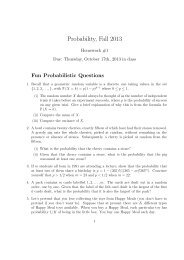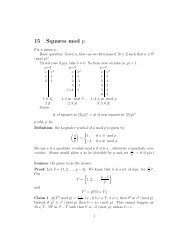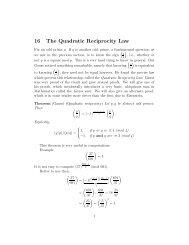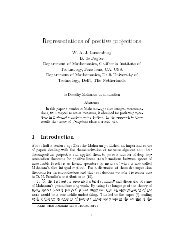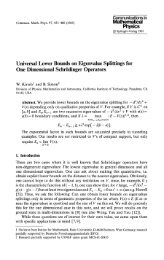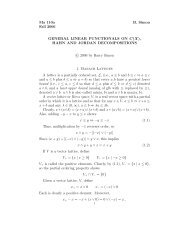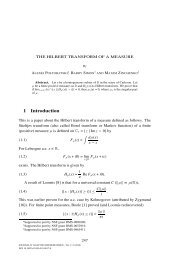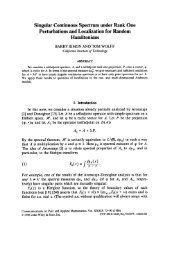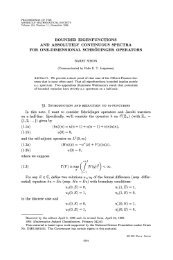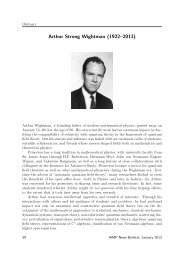Physics - Mathematics Department - California Institute of Technology
Physics - Mathematics Department - California Institute of Technology
Physics - Mathematics Department - California Institute of Technology
You also want an ePaper? Increase the reach of your titles
YUMPU automatically turns print PDFs into web optimized ePapers that Google loves.
Communications in<br />
Commun. Math. Phys. 116, 635-644 (1988) Mathematical<br />
<strong>Physics</strong><br />
© Springer-Verlag 1988<br />
Approximate Neutrality <strong>of</strong> Large-Z Ions*<br />
Elliott H. Lieb 1 , Israel M. Sigal 2 , Barry Simon 3 and Walter Thirring 4<br />
1 <strong>Department</strong>s <strong>of</strong> <strong>Mathematics</strong> and <strong>Physics</strong>, Princeton University, Princeton, NJ 08544, USA<br />
2 <strong>Department</strong> <strong>of</strong> <strong>Mathematics</strong>, University <strong>of</strong> Toronto, Toronto, Canada M5S 1A1<br />
3 Division <strong>of</strong> <strong>Physics</strong>, <strong>Mathematics</strong> and Astronomy, <strong>California</strong> <strong>Institute</strong> <strong>of</strong> <strong>Technology</strong>, Pasadena, CA<br />
91125, USA<br />
4 <strong>Institute</strong> for Theoretical <strong>Physics</strong>, University <strong>of</strong> Vienna, Vienna, Austria<br />
Abstract. Let N(Z) denote the number <strong>of</strong> electrons which a nucleus <strong>of</strong> charge<br />
Z can bind in non-relativistic quantum mechanics (assuming that electrons are<br />
fermions). We prove that JV(Z)/Z-> 1 as Z-> oo.<br />
1. Introduction<br />
This paper is a contribution to the exact study <strong>of</strong> Coulombic binding energies in<br />
quantum mechanics. Let H(N, Z) denote the Hamiltonian<br />
H(N,Z)= Σί-^-ziXiΓ'J+Σl^-^ Γ 1<br />
,<br />
i= 1 i
636 E. H. Lieb, I. M. Sigal, B. Simon and W. Thirring<br />
Zhislin [15] proved that N(Z) ^ Z and N b (Z) Ξ> Z. A more detailed review <strong>of</strong> the<br />
history and status <strong>of</strong> this and related problems is given in [7].<br />
Our main goal in this paper is to show that<br />
Theorem 1.1. lim [N(Z)/Z] = 1.<br />
Z->oo<br />
That is, asymptotically, the excess charge in negative ions is a small fraction <strong>of</strong><br />
the total charge. While this is physically reasonable, and partially captures the<br />
observed fact that in nature there are no highly negative ions, it is not as "obvious"<br />
as it might appear at first. For Benguria and Lieb [1] have shown that<br />
\imN b (Z)/Z>\.<br />
(They actually prove that lim is at least the critical charge for the Hartree equation<br />
which is rigorously known to lie between 1 and 2, and numerically [16] is about<br />
1.2.) Thus, the Pauli principle will enter into our pro<strong>of</strong> <strong>of</strong> Theorem 1.1.<br />
Part <strong>of</strong> our argument closely follows that in Sigal [12] (see also Cycon et al.<br />
[13]). We differ from Sigal in one critical aspect. He gets a factor <strong>of</strong> 2 in (1.1) by<br />
using the obvious fact that if one has 2Z + 1 electrons surrounding a nucleus <strong>of</strong><br />
charge Z, one can always gain classical energy by taking the electron farthest from<br />
the nucleus to infinity. We will exploit the fact that if you have Z(l -f ε) electrons<br />
and Z is large, classical energy can be gained by taking some electron to infinity.<br />
We will prove precisely this fact in Sect. 3. Actually, for technical reasons, we will<br />
need a slightly stronger result, also proven there. Unfortunately, our pro<strong>of</strong> <strong>of</strong> this<br />
key classical fact is by contradiction, using a compactness result. Hence our pro<strong>of</strong><br />
is non-constructive, which means that we have no estimates on how large Z has<br />
to be for N(Z)/Z to be bounded by 1 + ε for any given ε.<br />
The theorem we prove in Sect. 3 says that, with N = Z(l + ε) point electrons,<br />
one gains classical energy by taking some electron to infinity. We prove this by<br />
appealing to an analogous result for a "fluid" <strong>of</strong> negative charge: if \dp(x) ^ Z(l + ε),<br />
then for some x 0 in suppp one has Z\x o \~ ι - j\x 0 -y\~ 1 dp(y)^0. This fact is<br />
proven in Sect. 2. It is interesting that our results in quantum potential theory<br />
require various results in classical potential theory.<br />
In Sect. 4, we construct a partition <strong>of</strong> unity in [R 3iV -the result <strong>of</strong> Sect. 3 is needed<br />
only to assure that certain sets over U 3N . Given this partition, the actual pro<strong>of</strong> <strong>of</strong><br />
Theorem 1.1. in Sect. 5 follows Sigal [12]. Section 6 provides some additional<br />
remarks.<br />
2. Classical Continuum Theorem<br />
Theorem 2.1. Let p be a nonzero finite (positive) measure on U 3 which is not a point<br />
mass at 0, and let φ p be its potential, i.e.,<br />
Then, for any ε > 0, the set <strong>of</strong> points xφΰ such that<br />
has positive p measure.<br />
Φ P(x) = ί\x-yΓ 1 dp(y). (2.1)<br />
^(x)^(l-ε)|xΓV(^ 3<br />
) (2-2)
Approximate Neutrality <strong>of</strong> Large-Z Ions 637<br />
Pro<strong>of</strong>. Let Tε denote the set <strong>of</strong> points in U 3<br />
\{0} such that (2.2) holds. Our goal<br />
is to show that p(Tε ) > 0. First, let us eliminate any possible small point mass at<br />
0 by defining p = p — cδ(x). For some 0 ^ c < 1,β({0}) = 0. Additionally, defining<br />
ε = εp(U 3<br />
)/p(U 3<br />
% one sees that proving the theorem for ε and p is equivalent to<br />
proving it for ε and p with (1 — ε)p(U 3<br />
) > c. It suffices to assume, therefore, that<br />
s = ε,p = p and p({0}) = 0, and we shall do so henceforth.<br />
Let B denote the set <strong>of</strong> x φ 0 for which φp (x) = oo. If ρ(B) > 0 we are trivially<br />
done, so assume p(B) = 0. Since ρ({0}) = 0, this means that φp is finite p-a.e. and<br />
we can apply Baxter's Theorem 2 [17]. If we define the measure μ = (l—ε)<br />
{jdp}δ(x), this theorem asserts the existence <strong>of</strong> a (positive) measure y such that<br />
(a) y^p and y(U 3 ) ^ p(U 3 )-μ(U 3 ) = ε\dp > 0,<br />
(b) φ p {x) = φ γ (x) + φ μ (x)y.a.e..<br />
(In Baxter's notation, p = v,p-y = λ and μ = μ.) Thus, p(TJ ^ γ(T ε ) = y(U 3 ) > 0.<br />
Π<br />
Remark. One can also prove this theorem by appealing to Choquet's theorem [2,5].<br />
3. Classical-Discrete Theorem<br />
Theorem 3.1. For any ε, there exists N o so that, for all sets {3c α }^ = 1 <strong>of</strong>N ^ N o points,<br />
we have<br />
afb<br />
Remarks. This is clearly a classical analog <strong>of</strong> the quantum theorem that we are<br />
seeking. It says that if the electron excess over the nuclear charge above Z is more<br />
than ε(l — ε)~ 1 Z, then one gains energy by moving at least one <strong>of</strong> the electrons<br />
<strong>of</strong>f to infinity.<br />
2. Unfortunately, our pro<strong>of</strong> is by contradiction, and therefore non-constructive.<br />
The fact that we cannot make our estimates explicit, even in principle, comes from<br />
this fact.<br />
Pro<strong>of</strong>. Suppose not. Then, there is ε0 > 0 and sequences points {x ( a ] }a = i<br />
Nn^>co and<br />
w r t n<br />
- i α-βnw. ( 1 1 )<br />
for all n and all 1 ^b^N n.<br />
Equation (3.1) is invariant under rotations and scaling <strong>of</strong> the x's as well as<br />
relabelling. Thus, without loss we can suppose that<br />
The measures<br />
x^ = (1,0,0) = x 0,<br />
|xi π)<br />
|^l all \^a^Nn.
638 E. H. Lieb, I. M. Sigal, B. Simon and W. Thirring<br />
are probability measures on the unit ball. Thus, by passing to a subsequence if<br />
necessary, we can suppose that pn converges in the C(ίR 3<br />
)-weak topology to a<br />
probability measure dp. We will show that dp violates Theorem 2.1. If y is a limit<br />
point <strong>of</strong> x|" }<br />
and g(z) = (|z| 2<br />
+ M 2<br />
)~ 1/2<br />
, then since g is C 1<br />
with bounded derivatives<br />
Thus, by (3.1):<br />
lim \g(x - χW)dp H (x) = \g(x - y)dp(x).<br />
Sg(x-y)dp(x)£(l-ε o )\y\-K<br />
By the monotone convergence theorem, we can take M to zero to obtain<br />
$\x-y\-'dp(x)^(l-ε)\yΓK (3.2)<br />
We have just proven (3.2) for any y in the limit set <strong>of</strong> the {x£°}. Any yesuppp<br />
is such a limit point so (3.2) holds for all yesupp p. Thus we will have a contradiction<br />
with Theorem 2.1 if we show that p φδ 0 . But since x ( p = χ θ9 we have (3.2) for<br />
y = x 0 , i.e.,<br />
$\x-x 0 Γ ι dp(x)^(l-8). (3.3)<br />
Since, for dp = δ 0 , the left side is 1, we can conclude that dpΦδ 0 . •<br />
We will actually need an extension <strong>of</strong> Theorem 3.1 to potentials cut <strong>of</strong>f at short<br />
distances, but in a way that may seem unnatural at first. Define<br />
For a set <strong>of</strong> points {x fl }^ =1 in R 3 , define Ixl^ = sup|x β |.<br />
a<br />
£.7^' *I |ΐαΐxΐ (14)<br />
Theorem 3.2. Let α N -^0αsiV->oo. Then, for any ε, there exists N o and δ > 0 so<br />
that, for any N ^ N o and any set <strong>of</strong> points {x a }%= 1 , there is a point x a with \x a \'^.δ\x\ O0<br />
and<br />
Y G (x γ ) > ^ ~ £ ^ N Π 5Ϊ<br />
jψa IXfl I<br />
Pro<strong>of</strong>. G is defined to be invariant under scaling (which is why we took the cut<strong>of</strong>f<br />
to be α|x|, not just α) and rotations. Also, the condition |x α| ^ (Slx^ has the same<br />
invariance. Thus, if the result is false, we can find ε 0 > 0, δ N -• 0 and a sequence<br />
with Ixl^ = 1; x^ = (1,0,0) so that (3.5) fails. Taking the limit, we get the same<br />
contradiction as in the pro<strong>of</strong> <strong>of</strong> Theorem 3.1. •<br />
4. A Partition <strong>of</strong> Unity<br />
As noted in Sect. 1, the key element in the pro<strong>of</strong> <strong>of</strong> Sigal, which we will mimic, is<br />
the construction <strong>of</strong> a partition <strong>of</strong> unity. Here we will construct such a partition<br />
which we will use in the next section. The preliminaries in the last section will be<br />
relevant precisely in order to be sure that certain sets cover U 3N<br />
.<br />
Theorem 4.1. For all ε > 0, there exists No and δ > 0, and for each N ^ iV0 and each<br />
R>0, a family {Jα }^= 0 <strong>of</strong> C functions on U 3N<br />
so that:
Approximate Neutrality <strong>of</strong> Large-Z Ions 639<br />
(1) J o is totally symmetric, {J a } a ψo ί5 symmetric in {Xb}bfa<br />
(3) suppJo > X iv)<br />
// \l/2<br />
For if Jfl = Fα / ( ΣFj<br />
as F has, and/<br />
V<br />
1 , then Ja has the same symmetry and support properties<br />
J<br />
Σ<br />
2<br />
Σ (4.2)<br />
To understand (4.2), think <strong>of</strong> F = (Fo,..., FN) as a function from R 3N to R N+ \ in<br />
which case J is the "angular" part <strong>of</strong> F, and (4.2) is a standard inequality on the<br />
gradient <strong>of</strong> the angular part.<br />
Now we concentrate on constructing the Ffl's. Let φ be a C 00<br />
function on [0, oo)<br />
with<br />
e[0,l] all y<br />
and define φ = ι/^ 2<br />
. Let αN = (In A^)" 1<br />
and choose Nθ9δ as given by Theorem 3.2.<br />
As a preliminary, take F0,Ffl as follows. These functions are not C 00<br />
, but are<br />
continuous and are C 1 <strong>of</strong>f the set {x| |xj = |xb | for some a =£b}κj{x\ \xa — xb \ =<br />
oίN \xa \ some a,b} with discontinuities <strong>of</strong> the gradients allowed on that set:<br />
F 0(x) = l-ψ(\x\J 9<br />
Σ<br />
bfa
640 E. H. Lieb, I. M. Sigal, B. Simon and W. Thirring<br />
where G α is given by (3.3). The symmetry condition (1) is obvious, and (3) holds<br />
since φ(y)= 1 if y^l.<br />
F a Φ0 implies that 1*1^1-2^ \x a \ ^(1 -ε^lxU, and<br />
Σ<br />
bfa<br />
since φ(y) Φ 0 implies \y| ^ 1 — 2ε. Since \x — y\~* ^ G α (x,j/), we have proven (4).<br />
That leaves the key conditions (5') and (2').<br />
For (2'), we use Theorem 3.2. This guarantees us that there is an a where the<br />
last two factors in F a are 1, and so there is an a with F a(x) =
Approximate Neutrality <strong>of</strong> Large-Z Ions<br />
have that<br />
Thus<br />
bfa<br />
X \Vbηa\ 2<br />
^N-HlnNf\xa\- 2<br />
\φ'(N-'\xa\ X Gα^(xfl,x&))T. (4.6)<br />
As a final gradient estimate,<br />
since |VJx α | | = 1 and<br />
X<br />
bfa<br />
(x a ,x b ) 2 ],<br />
J<br />
and α ^ 1. Thus, since |xj X G α ^(x fl ,x b ) ^ N when φ'( ) ^0,<br />
1 f a<br />
— 1 i i V /^ /<br />
xJ > G^ (x fl ,x<br />
ι a\ JLJ a N \ ai<br />
Since |x a | ^(1 — 2ε) 5|x|oo on suppF α , we see that, for α#0.<br />
by using (4.3)-(4.7). Thus<br />
Σ<br />
a,b<br />
Since Xi 72 ^ i, we can take γ = N~ 1/2 and obtain:<br />
or<br />
X<br />
bfa<br />
641<br />
(4-7)<br />
as required.<br />
The J's constructed in this way are continuous but are only piecewise C 1 . By<br />
convoluting with a smooth, totally symmetric function <strong>of</strong> very small support, we<br />
can arrange for C 00 J's which still obey the required properties. •<br />
Remark. By using φ = ψ m in the above construction for m suitable, we can reduce<br />
N 1/2<br />
to any desired positive power <strong>of</strong> N.<br />
5. The Main Theorem<br />
Here we will prove Theorem 1.1. Given the construction in the last section, this<br />
follows Sigal [12] fairly closely. Pick ε > 0. We shall prove ϊϊm N(Z)/Z ^ (1 - 3ε)~ K
642 E. H. Lieb, I. M. Sigal, B. Simon and W. Thirring<br />
Let {J a } be as in Theorem 4.1, and let<br />
N<br />
L— y<br />
By the IMS localization formula (see Chap. 3 <strong>of</strong> [3]),<br />
By condition (5) <strong>of</strong> Theorem 4.1,<br />
Σ t (5.1)<br />
α=0 α=0<br />
L SCN 1/2 (In Nflx^R-K<br />
For α>0, supp J α c {x| \x a\ ^(1 — 2ε)(5|x| 00}, and thus:<br />
J aLJ a^c 1N 1/2 (\nN) 2 \x aΓ 1 R- ί (C 1=c^- 1 (l-2ε)" 1 ). (5.2)<br />
Since usupp(V JJ c {χ| Ix^ ^ (1 - 2ε)Λ}:<br />
J 0LJ 0 ^ c 2N 1/2 {\nN) 2 R~ 2 (c 2 = (1 - 2s)' 1 C) (5.3)<br />
Let H a(N — 1,Z) be the (iV— 1) electron Hamiltonian obtained by removing<br />
from H(N,Z) all terms involving x a, so:<br />
H(N,Z) = H a(N-lZ)-A a-\x a\~ 1 Z+ ^ l^-xj' 1 .<br />
Since H fl(iV - 1,Z) ^ E(N - 1,Z) and - 4 α ^ 0, taking into account (5.2) and the<br />
support property <strong>of</strong> J a, we have that<br />
where<br />
(5.4a)<br />
d{Z,N,R) = - Z - ^N^ilnNfR- 1 + (1 - 2ε)N. (5.4b)<br />
^ N has not been introduced up to now.<br />
By solving for a Bohr atom (and this is where the Pauli principle enters):<br />
so since \x a — x b\^2R on supp J o:<br />
J0(H{N,Z)-L)J0^J0[-c3Z 2<br />
N 1/3<br />
-c2N 1/2<br />
(\nN) 2<br />
R- 2<br />
+iR- 1<br />
N{N-l)TiJ0. Choose i^ = N~ 215<br />
. Then, for iV ^ (1 - 3ε)" ι<br />
Z and large Z, d(Z, N, R) > 0 since<br />
i + f
Approximate Neutrality <strong>of</strong> Large-Z Ions 643<br />
Since ε is arbitrary:<br />
It is well known (see [15,13]) that H{Z,Z) has bound states, i.e., that<br />
Z. •<br />
Remark. Without the Pauli principle, Z 2<br />
N 113<br />
becomes Z 2<br />
N, so one must take<br />
RN = cN' 1<br />
, in which case the localization term N ll2<br />
(\nN) 2<br />
R^ i<br />
in (5.4b) becomes<br />
uncontrollable. Our pro<strong>of</strong> must, <strong>of</strong> course, fail without the Pauli principle because<br />
<strong>of</strong> the result in [1].<br />
6. Extensions<br />
Our result extends easily to accommodate arbitrary magnetic fields (the same for<br />
all electrons) and/or a finite nuclear mass.<br />
The exact form <strong>of</strong> the electron kinetic energy entered only in two places: in the<br />
IMS localization formula and in the positivity <strong>of</strong> — Δ, both <strong>of</strong> which hold in an<br />
arbitrary magnetic field. We also used the Bohr atom binding energy, but that<br />
only decreases in a magnetic field (i.e., — c 3 N 2 Z 1/3 is a lower bound for all fields).<br />
Thus, we obtain a magnetic field independent bound N{Z) with<br />
N(Z)/Z-+1 as Z-+oo.<br />
As for finite nuclear mass, let x 0 be the nuclear coordinate, and use J a (x b — x 0 )<br />
in place oϊ J a (x b ). With this change, the nuclear coordinates pass through all pro<strong>of</strong>s<br />
with essentially no change at all.<br />
Acknowledgement. This work was begun while I.S. was at the Weizmann <strong>Institute</strong>, and B.S. would like<br />
to thank H. Dym and I. Sigal for the hospitality <strong>of</strong> that <strong>Institute</strong>. W.T. would like to thank E. Lieb<br />
for the hospitality <strong>of</strong> Princeton University, and M. Goldberger and R. Vogt for the hospitality <strong>of</strong><br />
Caltech. An announcement appeared in [8].<br />
References<br />
1. Benguria, R., Lieb, E.: Pro<strong>of</strong> <strong>of</strong> the stability <strong>of</strong> highly negative ions in the absence <strong>of</strong> the Pauli<br />
principle. Phys. Rev. Lett. 50, 1771 (1983)<br />
2. Choquet, G.: Sur la fondements de la theorie finie du potential. C.R. Acad. Sci. Paris 244,1606 (1957)<br />
3. Cycon, H., Froese, R., Kirsch, W., Simon, B.: Schrδdinger operators with application to quantum<br />
mechanics and global geometry. Berlin, Heidelberg, New York: Springer 1987<br />
4. Evans, G.: On potentials <strong>of</strong> positive mass, I. Trans. AMS 37, 226 (1935)<br />
5. Helms, L.: Introduction to potential theory. New York: Wiley 1966<br />
6. Lieb, E.: Atomic and molecular ionization. Phys. Rev. Lett. 52, 315 (1984)<br />
7. Lieb, E.: Bound on the maximum negative ionization <strong>of</strong> atoms and molecules. Phys. Rev. A29,<br />
3018-3028 (1984)<br />
8. Lieb, E., Sigal, I. M., Simon, B., Thirring, W.: Asymptotic neutrality <strong>of</strong> large-Z ions. Phys. Rev.<br />
Lett. 52, 994 (1984)<br />
9. Ruskai, M. Absence <strong>of</strong> discrete spectrum in highly negative ions. Commun. Math. Phys. 82,457-469<br />
(1982)<br />
10. Ruskai, M.: Absence <strong>of</strong> discrete spectrum in highly negative ions, II. Commun. Math. Phys. 85,<br />
325-327(1982)
644 E. H. Lieb, I. M. Sigal, B. Simon and W. Thirring<br />
11. Sigal, I. M.: Geometric methods in the quantum many-body problem. Nonexistence <strong>of</strong> very negative<br />
ions. Commun. Math. Phys. 85, 309-324 (1982)<br />
12. Sigal, I. M.: How many electrons can a nucleus bind? Ann. Phys. 157, 307-320 (1984)<br />
13. Simon, B.: On the infinitude or finiteness <strong>of</strong> the number <strong>of</strong> bound states <strong>of</strong> an JV-body quantum<br />
system, I. Helv. Phys. Acta 43, 607-630 (1970)<br />
14. Vasilescu, F.: Sur la contribution du potential a traverse des masses et la demonstration d'une<br />
lemme de Kellogg. C.R. Acad. Sci. Paris 200, 1173 (1935)<br />
15. Zhislin, G.: Discussion <strong>of</strong> the spectrum <strong>of</strong> Schrodinger operator for systems <strong>of</strong> many particles. Tr.<br />
Mosk. Mat. Obs. 9, 81-128 (1960)<br />
16. Baumgartner, B.: On Thomas-Fermi-von Weizsacker and Hartree energies as functions <strong>of</strong> the<br />
degree <strong>of</strong> ionisation. J. Phys. A17, 1593-1602 (1984)<br />
17. Baxter, J.: Inequalities for potentials <strong>of</strong> particle systems, 111. J. Math. 24, 645-652 (1980)<br />
Communicated by A. Jaffe<br />
Received December 7, 1987



